Riza Batista-Navarro
Natural Language Satisfiability: Exploring the Problem Distribution and Evaluating Transformer-based Language Models
Aug 23, 2025Abstract:Efforts to apply transformer-based language models (TLMs) to the problem of reasoning in natural language have enjoyed ever-increasing success in recent years. The most fundamental task in this area to which nearly all others can be reduced is that of determining satisfiability. However, from a logical point of view, satisfiability problems vary along various dimensions, which may affect TLMs' ability to learn how to solve them. The problem instances of satisfiability in natural language can belong to different computational complexity classes depending on the language fragment in which they are expressed. Although prior research has explored the problem of natural language satisfiability, the above-mentioned point has not been discussed adequately. Hence, we investigate how problem instances from varying computational complexity classes and having different grammatical constructs impact TLMs' ability to learn rules of inference. Furthermore, to faithfully evaluate TLMs, we conduct an empirical study to explore the distribution of satisfiability problems.
* The paper was accepted to the 62nd Association for Computational Linguistics (ACL 2024), where it won the Best Paper Award
Silent Hazards of Token Reduction in Vision-Language Models: The Hidden Impact on Consistency
Mar 11, 2025Abstract:Vision language models (VLMs) have excelled in visual reasoning but often incur high computational costs. One key reason is the redundancy of visual tokens. Although recent token reduction methods claim to achieve minimal performance loss, our extensive experiments reveal that token reduction can substantially alter a model's output distribution, leading to changes in prediction patterns that standard metrics such as accuracy loss do not fully capture. Such inconsistencies are especially concerning for practical applications where system stability is critical. To investigate this phenomenon, we analyze how token reduction influences the energy distribution of a VLM's internal representations using a lower-rank approximation via Singular Value Decomposition (SVD). Our results show that changes in the Inverse Participation Ratio of the singular value spectrum are strongly correlated with the model's consistency after token reduction. Based on these insights, we propose LoFi--a training-free visual token reduction method that utilizes the leverage score from SVD for token pruning. Experimental evaluations demonstrate that LoFi not only reduces computational costs with minimal performance degradation but also significantly outperforms state-of-the-art methods in terms of output consistency.
BRIDGE: Bootstrapping Text to Control Time-Series Generation via Multi-Agent Iterative Optimization and Diffusion Modelling
Mar 05, 2025



Abstract:Time-series Generation (TSG) is a prominent research area with broad applications in simulations, data augmentation, and counterfactual analysis. While existing methods have shown promise in unconditional single-domain TSG, real-world applications demand for cross-domain approaches capable of controlled generation tailored to domain-specific constraints and instance-level requirements. In this paper, we argue that text can provide semantic insights, domain information and instance-specific temporal patterns, to guide and improve TSG. We introduce ``Text-Controlled TSG'', a task focused on generating realistic time series by incorporating textual descriptions. To address data scarcity in this setting, we propose a novel LLM-based Multi-Agent framework that synthesizes diverse, realistic text-to-TS datasets. Furthermore, we introduce BRIDGE, a hybrid text-controlled TSG framework that integrates semantic prototypes with text description for supporting domain-level guidance. This approach achieves state-of-the-art generation fidelity on 11 of 12 datasets, and improves controllability by 12.52% on MSE and 6.34% MAE compared to no text input generation, highlighting its potential for generating tailored time-series data.
LongEval: A Comprehensive Analysis of Long-Text Generation Through a Plan-based Paradigm
Feb 26, 2025Abstract:Large Language Models (LLMs) have achieved remarkable success in various natural language processing tasks, yet their ability to generate long-form content remains poorly understood and evaluated. Our analysis reveals that current LLMs struggle with length requirements and information density in long-text generation, with performance deteriorating as text length increases. To quantitively locate such a performance degradation and provide further insights on model development, we present LongEval, a benchmark that evaluates long-text generation through both direct and plan-based generation paradigms, inspired by cognitive and linguistic writing models. The comprehensive experiments in this work reveal interesting findings such as that while model size correlates with generation ability, the small-scale model (e.g., LongWriter), well-trained on long texts, has comparable performance. All code and datasets are released in https://github.com/Wusiwei0410/LongEval.
Pay Attention to Real World Perturbations! Natural Robustness Evaluation in Machine Reading Comprehension
Feb 23, 2025Abstract:As neural language models achieve human-comparable performance on Machine Reading Comprehension (MRC) and see widespread adoption, ensuring their robustness in real-world scenarios has become increasingly important. Current robustness evaluation research, though, primarily develops synthetic perturbation methods, leaving unclear how well they reflect real life scenarios. Considering this, we present a framework to automatically examine MRC models on naturally occurring textual perturbations, by replacing paragraph in MRC benchmarks with their counterparts based on available Wikipedia edit history. Such perturbation type is natural as its design does not stem from an arteficial generative process, inherently distinct from the previously investigated synthetic approaches. In a large-scale study encompassing SQUAD datasets and various model architectures we observe that natural perturbations result in performance degradation in pre-trained encoder language models. More worryingly, these state-of-the-art Flan-T5 and Large Language Models (LLMs) inherit these errors. Further experiments demonstrate that our findings generalise to natural perturbations found in other more challenging MRC benchmarks. In an effort to mitigate these errors, we show that it is possible to improve the robustness to natural perturbations by training on naturally or synthetically perturbed examples, though a noticeable gap still remains compared to performance on unperturbed data.
LVPruning: An Effective yet Simple Language-Guided Vision Token Pruning Approach for Multi-modal Large Language Models
Jan 23, 2025



Abstract:Multi-modal Large Language Models (MLLMs) have achieved remarkable success by integrating visual and textual modalities. However, they incur significant computational overhead due to the large number of vision tokens processed, limiting their practicality in resource-constrained environments. We introduce Language-Guided Vision Token Pruning (LVPruning) for MLLMs, an effective yet simple method that significantly reduces the computational burden while preserving model performance. LVPruning employs cross-attention modules to compute the importance of vision tokens based on their interaction with language tokens, determining which to prune. Importantly, LVPruning can be integrated without modifying the original MLLM parameters, which makes LVPruning simple to apply or remove. Our experiments show that LVPruning can effectively reduce up to 90% of vision tokens by the middle layer of LLaVA-1.5, resulting in a 62.1% decrease in inference Tera Floating-Point Operations Per Second (TFLOPs), with an average performance loss of just 0.45% across nine multi-modal benchmarks.
TriG-NER: Triplet-Grid Framework for Discontinuous Named Entity Recognition
Nov 04, 2024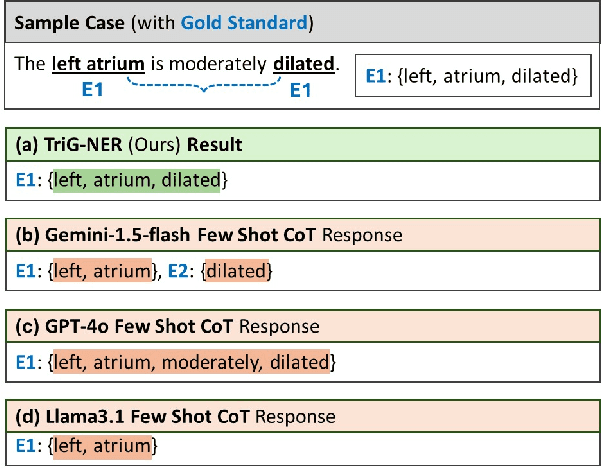
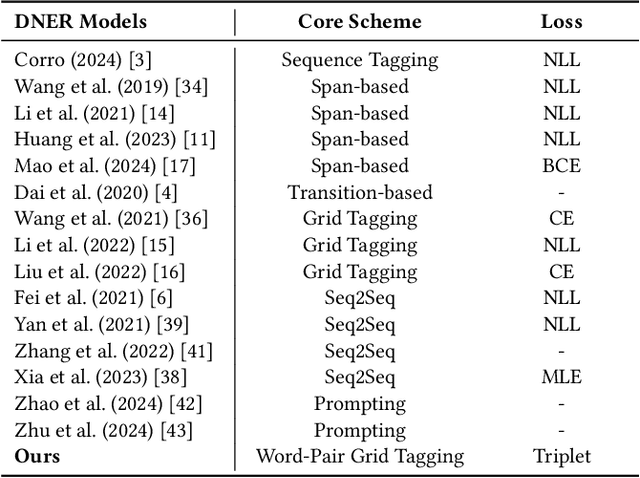
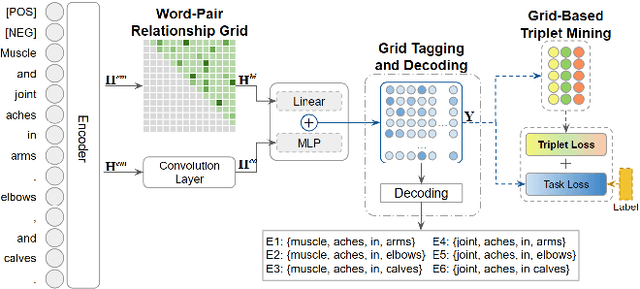
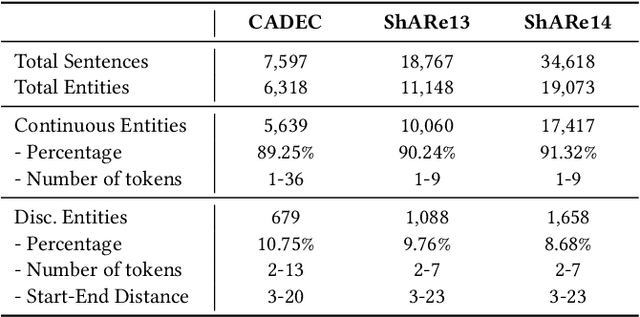
Abstract:Discontinuous Named Entity Recognition (DNER) presents a challenging problem where entities may be scattered across multiple non-adjacent tokens, making traditional sequence labelling approaches inadequate. Existing methods predominantly rely on custom tagging schemes to handle these discontinuous entities, resulting in models tightly coupled to specific tagging strategies and lacking generalisability across diverse datasets. To address these challenges, we propose TriG-NER, a novel Triplet-Grid Framework that introduces a generalisable approach to learning robust token-level representations for discontinuous entity extraction. Our framework applies triplet loss at the token level, where similarity is defined by word pairs existing within the same entity, effectively pulling together similar and pushing apart dissimilar ones. This approach enhances entity boundary detection and reduces the dependency on specific tagging schemes by focusing on word-pair relationships within a flexible grid structure. We evaluate TriG-NER on three benchmark DNER datasets and demonstrate significant improvements over existing grid-based architectures. These results underscore our framework's effectiveness in capturing complex entity structures and its adaptability to various tagging schemes, setting a new benchmark for discontinuous entity extraction.
Learning to Generate and Evaluate Fact-checking Explanations with Transformers
Oct 21, 2024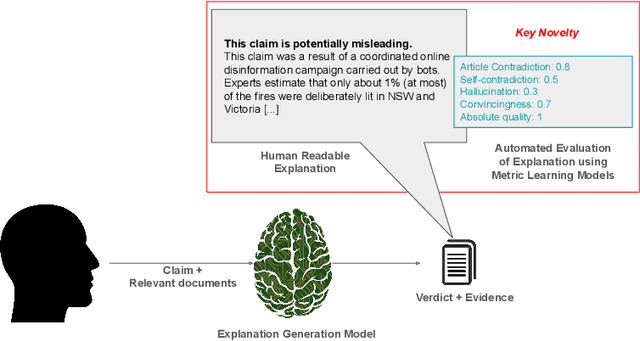
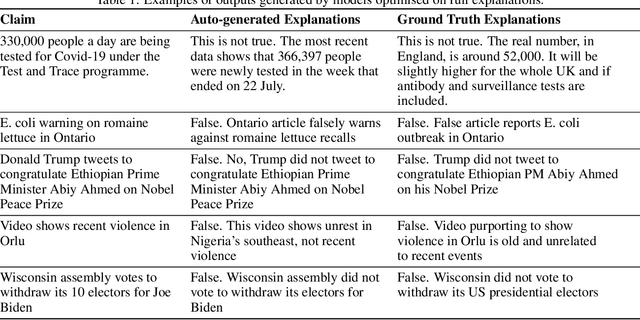


Abstract:In an era increasingly dominated by digital platforms, the spread of misinformation poses a significant challenge, highlighting the need for solutions capable of assessing information veracity. Our research contributes to the field of Explainable Artificial Antelligence (XAI) by developing transformer-based fact-checking models that contextualise and justify their decisions by generating human-accessible explanations. Importantly, we also develop models for automatic evaluation of explanations for fact-checking verdicts across different dimensions such as \texttt{(self)-contradiction}, \texttt{hallucination}, \texttt{convincingness} and \texttt{overall quality}. By introducing human-centred evaluation methods and developing specialised datasets, we emphasise the need for aligning Artificial Intelligence (AI)-generated explanations with human judgements. This approach not only advances theoretical knowledge in XAI but also holds practical implications by enhancing the transparency, reliability and users' trust in AI-driven fact-checking systems. Furthermore, the development of our metric learning models is a first step towards potentially increasing efficiency and reducing reliance on extensive manual assessment. Based on experimental results, our best performing generative model \textsc{ROUGE-1} score of 47.77, demonstrating superior performance in generating fact-checking explanations, particularly when provided with high-quality evidence. Additionally, the best performing metric learning model showed a moderately strong correlation with human judgements on objective dimensions such as \texttt{(self)-contradiction and \texttt{hallucination}, achieving a Matthews Correlation Coefficient (MCC) of around 0.7.}
Investigating a Benchmark for Training-set free Evaluation of Linguistic Capabilities in Machine Reading Comprehension
Aug 09, 2024
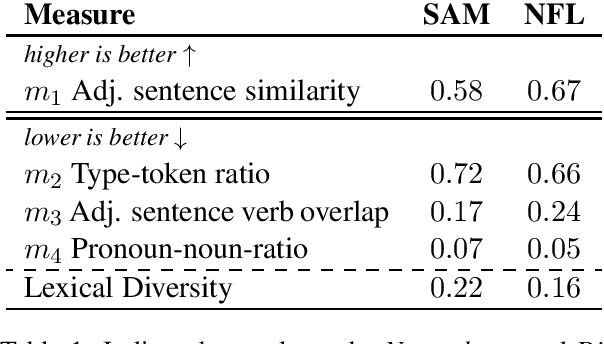
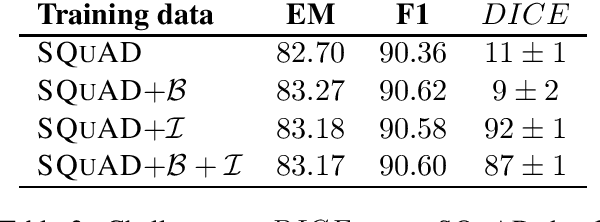

Abstract:Performance of NLP systems is typically evaluated by collecting a large-scale dataset by means of crowd-sourcing to train a data-driven model and evaluate it on a held-out portion of the data. This approach has been shown to suffer from spurious correlations and the lack of challenging examples that represent the diversity of natural language. Instead, we examine a framework for evaluating optimised models in training-set free setting on synthetically generated challenge sets. We find that despite the simplicity of the generation method, the data can compete with crowd-sourced datasets with regard to naturalness and lexical diversity for the purpose of evaluating the linguistic capabilities of MRC models. We conduct further experiments and show that state-of-the-art language model-based MRC systems can learn to succeed on the challenge set correctly, although, without capturing the general notion of the evaluated phenomenon.
Which Side Are You On? A Multi-task Dataset for End-to-End Argument Summarisation and Evaluation
Jun 06, 2024

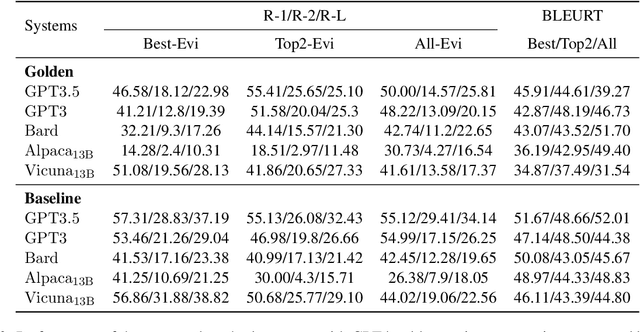

Abstract:With the recent advances of large language models (LLMs), it is no longer infeasible to build an automated debate system that helps people to synthesise persuasive arguments. Previous work attempted this task by integrating multiple components. In our work, we introduce an argument mining dataset that captures the end-to-end process of preparing an argumentative essay for a debate, which covers the tasks of claim and evidence identification (Task 1 ED), evidence convincingness ranking (Task 2 ECR), argumentative essay summarisation and human preference ranking (Task 3 ASR) and metric learning for automated evaluation of resulting essays, based on human feedback along argument quality dimensions (Task 4 SQE). Our dataset contains 14k examples of claims that are fully annotated with the various properties supporting the aforementioned tasks. We evaluate multiple generative baselines for each of these tasks, including representative LLMs. We find, that while they show promising results on individual tasks in our benchmark, their end-to-end performance on all four tasks in succession deteriorates significantly, both in automated measures as well as in human-centred evaluation. This challenge presented by our proposed dataset motivates future research on end-to-end argument mining and summarisation. The repository of this project is available at https://github.com/HarrywillDr/ArgSum-Datatset
 Add to Chrome
Add to Chrome Add to Firefox
Add to Firefox Add to Edge
Add to Edge